


Preserving history for future generations. Archive.org has it stored (hopefully it still going in 1,000 years time). My dad, Frederick Charles Parker Birmingham, enjoyed tracing his family tree. Proudly he displayed Captain Thomas Birmingham looking out over Ilfracombe harbour in our family home.

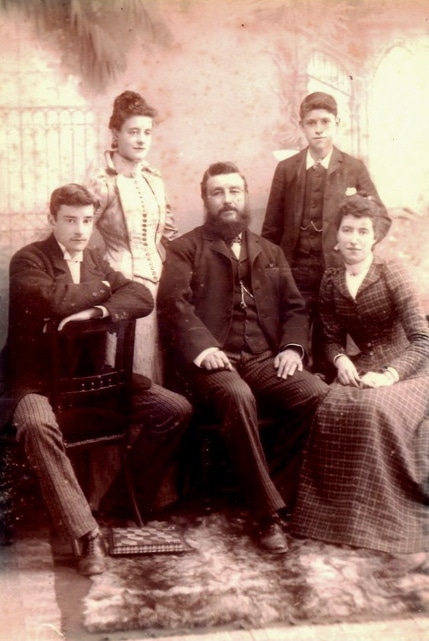
Rising the ranks aboard ships:



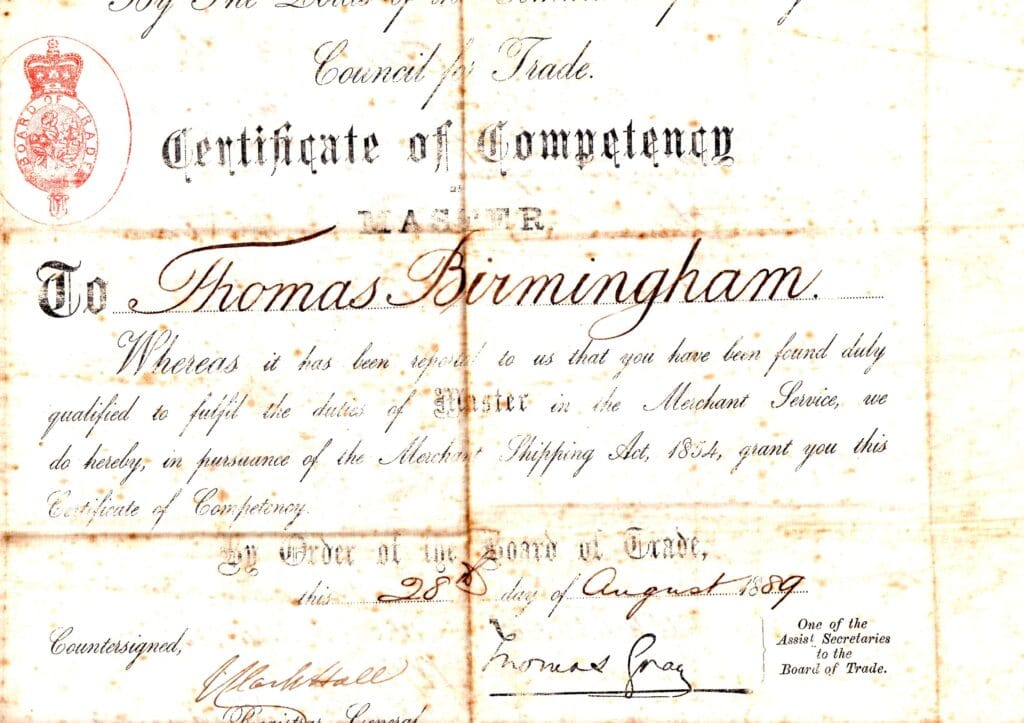
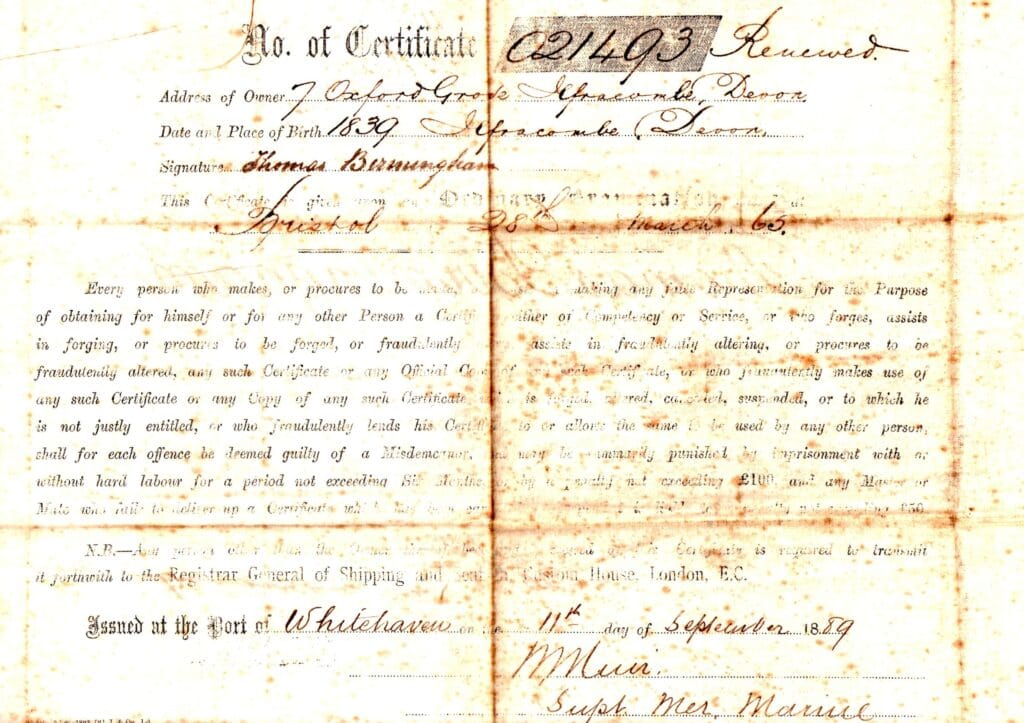



How much of Google Ads $500 Billion revenue generated in last 5 years is from kids of ‘undetermined’ ages cheating on exams by copying and pasting questions?
How much fat extracted from ‘enhanced CPC’?
Inflated bids from questionable bid suggestions?
General, taking advantage of people’s naivety in terms of ‘recommendations’?
That % would be interesting to know. How much discussion/strategy goes into purposeful manipulation; KPI-hitting versus human empathy.
Imitation is flattery, is the saying. Play-it-safe marketers tend to copy whatever the novel trend is (I’ve been there and got the t-shirt, so not a criticism or judgement). Sometimes clients follow an agency’s recommendation based on the success (proven or mere fluff) another client has achieved. Over the past year or so, nostalgic references have slowly crept into more and more TV ads. Possibly on the basis that nostalgia plays favourably in comforting people, and influencing their decisions, most commented on in the sphere of ‘make America great again’ and Brexit voters.
The likes of MoneySupermarket with Heman and Skeletor dancing; GI Joe dancing; Natwest reintroducing Ghostbusters; McDonalds with the BigMac through the decades; GWR reintroducing the Famous Five and so on.
More recently the trend seems to have morphed into displaying the customer as a zombie-like imbecile.
It will be interesting to see which other brands start to follow this trend, and ultimately how consumers react in terms of purchasing behaviour.
A reflective question to start: if a carpenter stops to quantify the level of friction on the plane – what is the impact on the final product? What is the impact to the current and ongoing process? For the individual carpenter, their team and the wider business?
With Google now offering the ability to automatically link Google Analytics and Firebase (web + app) data, a new dawn of event-based tracking (and conversation) is here. Having used Firebase for the past few years, the granular event data offering out-of-the-box is phenomenally enriching, over and above basic conversation and perspectives glinted on the surface by Google Analytics UI reporting and dashboards.
A real-world example:
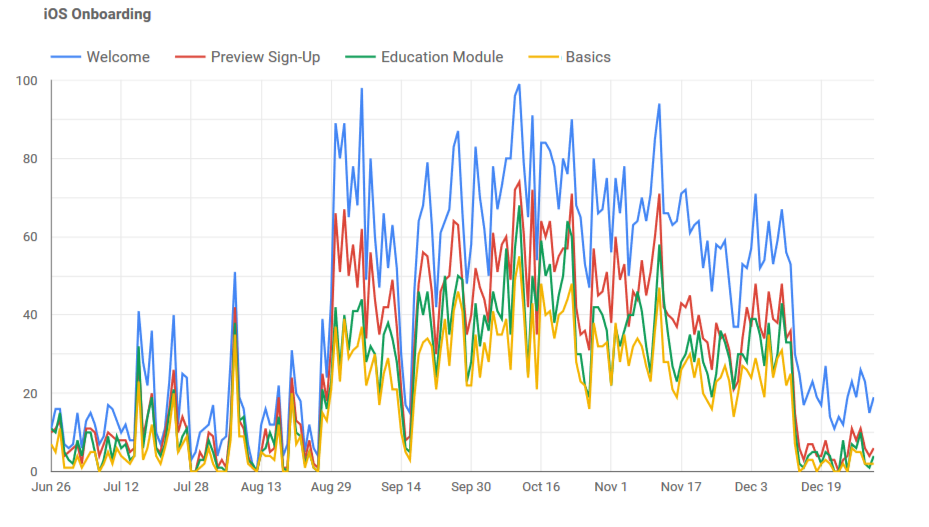
The chart below shows a series of on-boarding events for an iOS app collected by Firebase (creating useful product insight and a UX / performance funnel to improve – nice!).
At a top-level this perspective shows drop off between events and potential opportunities to improve. Conversion rates overall, per step, monetised event values can be created to dive further and start to assess commercial impact and resource allocation.
But here’s why events are useful – pivot by any data point you like to create a new perspective. For example, by device model:

A quick tangent – I love this perspective in terms of how it can help define top-level strategy, filtering through to items such as device servicing for customer SLAs. Stitching together strategy with operations, internally and externally, is a stable coherent starting point for future conversations, internally and externally.
In the example above we’re looking at 4 events across 3 screens. Even this low definition provides a decent starting point to start tweaking product strategy. What if we track 60 extra events into the same user journey? Would this enrich the data? Would it provide new insight?
Most probably in the example above. A good abstract way to look at event tracking is consider frames per second (typically I’m thinking animated GIFs here). To few frames per second and the picture may not be fully formed (spot the 2nd football in the image below!).

Conversely, 120 FPS and 90 FPS below, there’s minimal discernible difference in the end output.

All of the metrics displayed so far have been hard numbers e.g. recording the fact, even softer behaviours have been recorded as events. They still require some calculation or interpretation (unless already automated).
An intriguing element of building out products is weaving in user feedback. Historically, for many companies this has happened outside of the product, isolated from the experience. Tools such as Intercom, Drift, Localytics enable in-product feedback to be collected in the moment, in sequence with the experience, for all types of deep analysis, personalisation, experimentation etc.
The feedback request could be moved in the journey, or repeated per event, or run as product experiments to improve the experience (based on key metrics optimised).
A basic example is asking the question: “What do you think of X feature?” Input box. To automate and scale this (if proved useful through prototyping), would be to create spin-off columns such as ‘Categorisation: complement; bug; request; other’ etc. That data can then be aggregated (e.g. 50% users encountered a bug) and used to quantify reasons behind drop-off. Bugs are most commonly spotted by tools designed for that task, so perhaps a better example is 75% users request an update to a feature (or provide feedback that they needed more info / didn’t understand). Clear pivotable data points have been created to provide that feedback and trend it going forwards.
This also generates data for more advanced segmentation and hypotheses. For example, are users who provide feedback (or a specific type of feedback) more likely to do X? Also, are they more likely than people who feedback Y to X? X could be share on social media or refer a friend as examples. Data collected primarily to inform product experience is now directed towards building behaviours that create new data points and growth potential.
Takeaways:
Data Studio is a free data visualisation tool from Google. It allows data to be pulled from various data sources such as Google Sheets, CSV files, SQL databases etc. or via pre-built API connectors from tools such as Google Analytics and BigQuery. Data Studio’s main advantage is the ability to quickly and iteratively visualise data in scorecards, tables and numerous styles of charts to create dashboards.
Product overview: https://support.google.com/datastudio/answer/6283323?hl=en
https://datastudio.google.com/ (Data Studio dot Google dot com)
If your Google account has been given shared access to existing reports, then they will appear in the main interface or if you click ‘Shared with me’ in the left-hand menu (desktop experience).
Additionally, Google provides several templates (including an introduction/onboarding guide) that you can click into and explore, which are already hooked up to data sources so that charts and other items are not blank. You can easily copy these reports and add your own data sources – it’s a good way to get familiarised with the product and start to get hands on with your data.
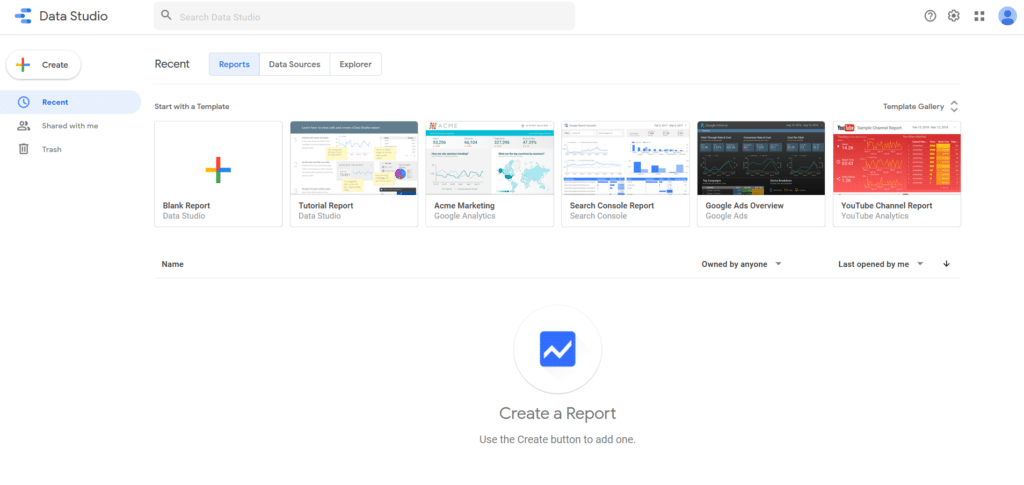
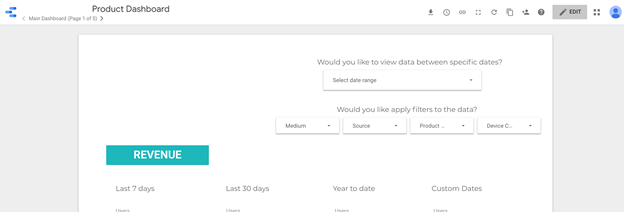
When you first open up a Data Studio dashboard you’ll be presented with a header like above. Breaking elements of this down:
Top left: Report name & pagination (if multiple pages exist)

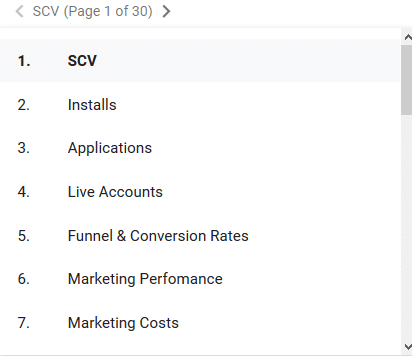
Top right (in order: left to right)
Clicking ‘Edit’ causes the page to refresh and new sub-menus to appear.

Text menu:
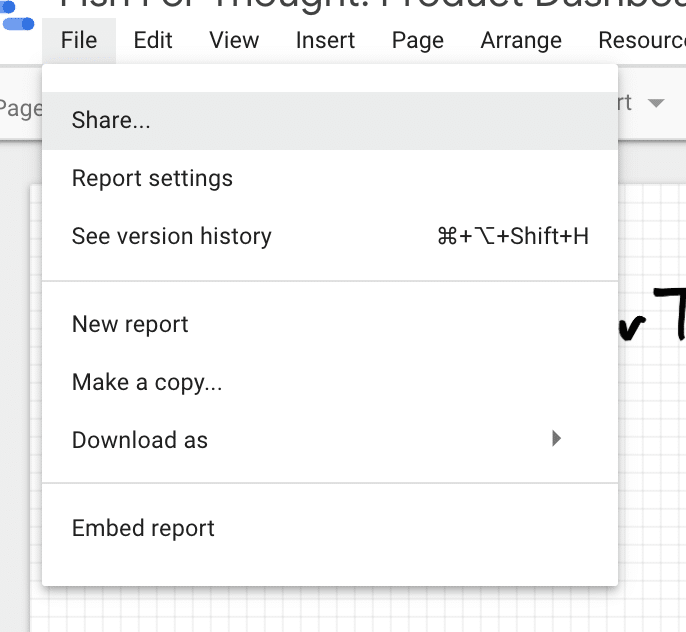
Under ‘File’ you have the option to ‘Share…’ the report.
‘Report Settings’ enables editors to set a default data source, date range dimension, Google Analytics ID and whether caching is enabled.
‘See version history’ allows you to view previous versions and rollback if needed.
‘New report’ creates a completely new blank report.
‘Make a copy…’ makes a duplicate copy of the report, creating a new file.
‘Download as’ enables editors to download the report as a PDF.
‘Enable embed’ provides <iframe> and a URL to directly embed the page into a HTML page etc.
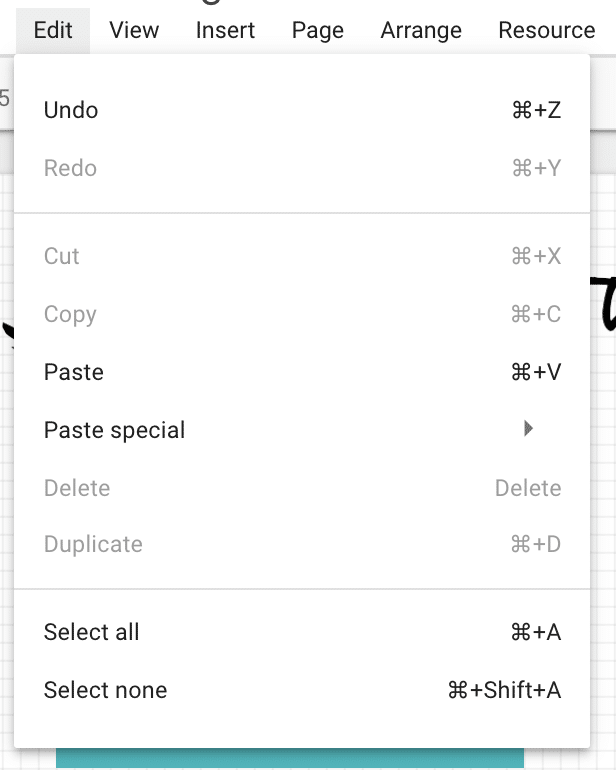
‘Edit’ link provides a number of shortcuts.
‘View’ allows a grid to be added to the report and re-sized, to improve the design and layout.
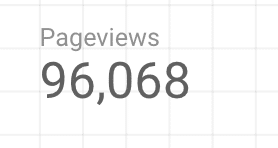
‘Insert’ allows editors to add different asset types to the report, such as charts, tables, maps, text, images, shapes, filters, date ranges etc.
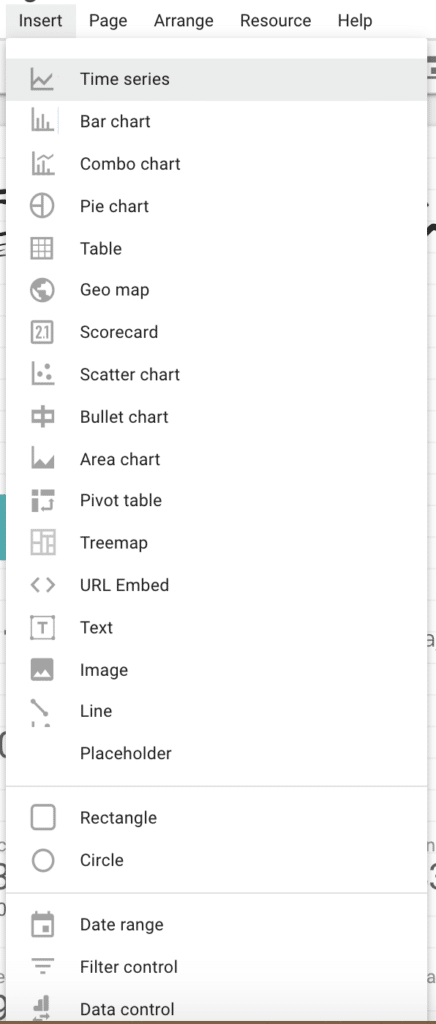
‘Page’ enables editors to create/copy/delete/skip pages.
‘Arrange’ allows alignment of elements and also bulk repetition operations, such as grouping elements, or copying a set of filters to every page.
‘Resource’ is a very handy menu that provides quick access to data sources and other options such as segments and filters at report-level (rather than page-level or chart-level).
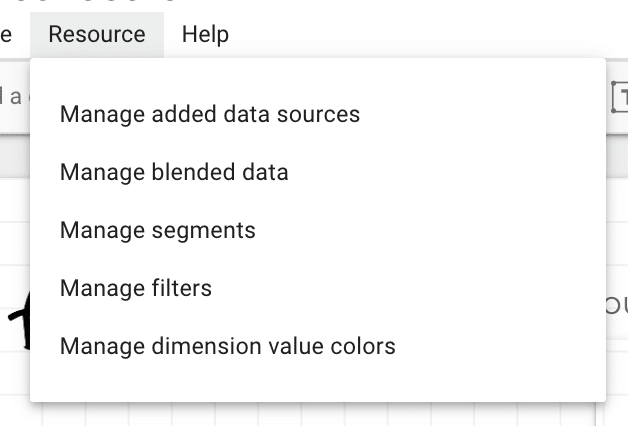
‘Help’ provides links to documentation, the Data Studio community forum, bug reporting / feature requests and video tutorials.
Sub-sub menu

Under the text-based menu described above (file, edit etc), there’s an icon-based menu illustrated above. This largely provides short-cuts to items already mentioned and available via the text-based menu.
These icons are:
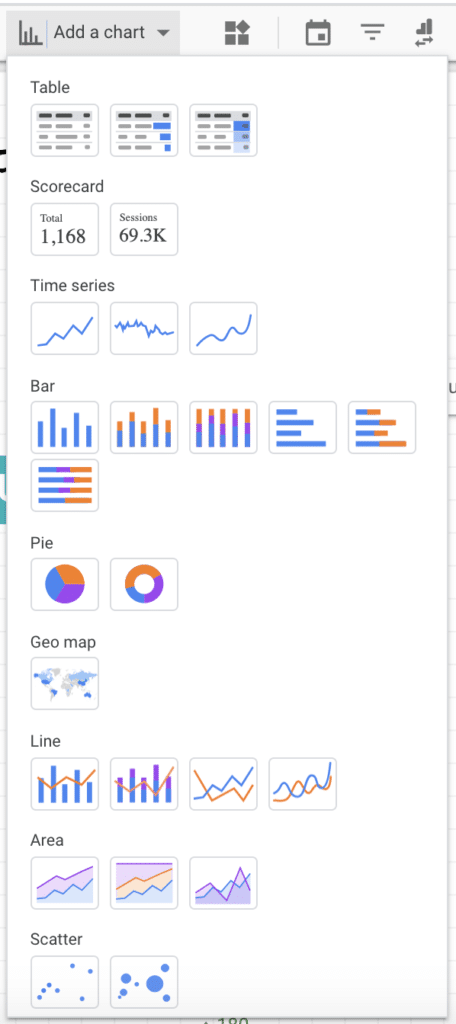
5) Community visualisations (not very useful at the moment imo)
6) Add a date range
7) Add a filter (filter data by any dimension or metric)
8) Data control (keep the same charts, swap the underlying data source)
9) Embed external content (e.g. another dashboard)
10) Add a text box
11) Add an image
12, 13, 14) Add lines and shapes
15) Layout and theme
Right-hand side menu
When you open up a new report or click on the background of a page, a ‘Layout and Theme’ menu will appear on the right-hand side. This allows control over a number of design items such as whether the report is full screen and responsive, or a standard fixed size. (I’ve always used a standard fixed size, as the responsiveness has not properly worked so far)
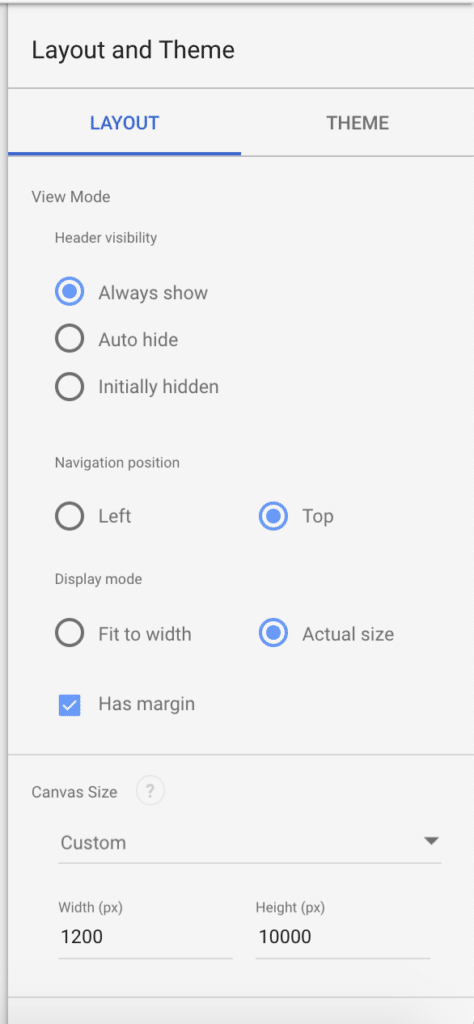
Once you’re ready to go there are two avenues to connect a data source to your report.
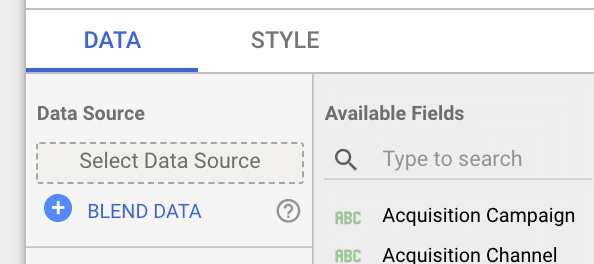
This screen will then pop up with Google Connectors and Partner Connectors:
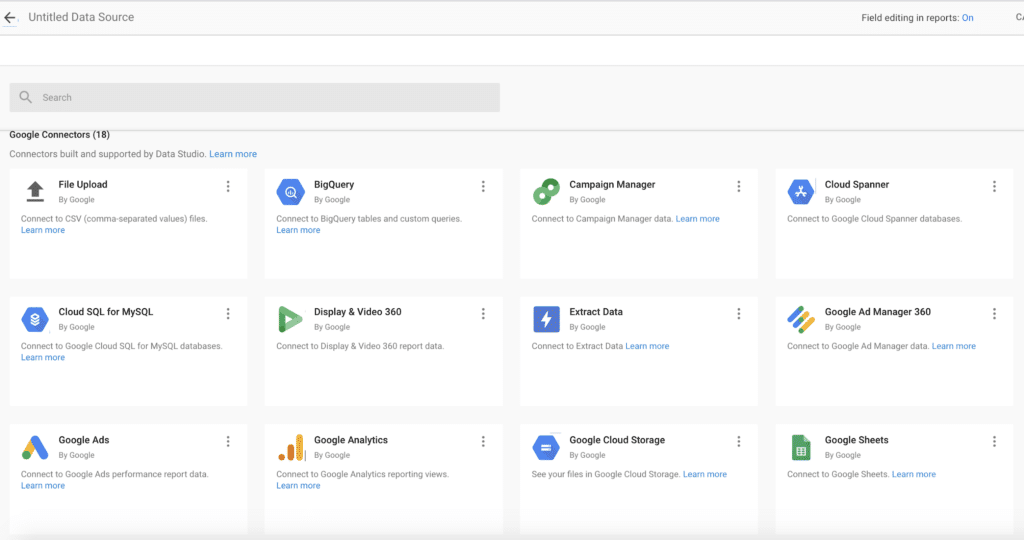
Once you’ve selected a connector and authenticated (if needed), Data Studio will pull in and display data points as dimensions (green) and metrics (blue).

You can change metrics to dimensions and vice versa. You can also duplicate metrics, rename them and change their format (e.g. changing a number to a percentage, or changing a number to text).
Click ‘Done’ to complete adding the data source.
If you edit a data source you can add new metrics, in the form of calculated metrics. This is really useful for transforming or cleaning data into a format that is more usable.
Documentation: https://support.google.com/datastudio/answer/6299685?hl=en
Tables allow you to add up to 20 dimensions and 20 metrics, which is very useful to get a base understanding of the data you’re working for (some charts only allow 1 dimension), so it’s worth drilling into the data in a table before going full out with different charts.
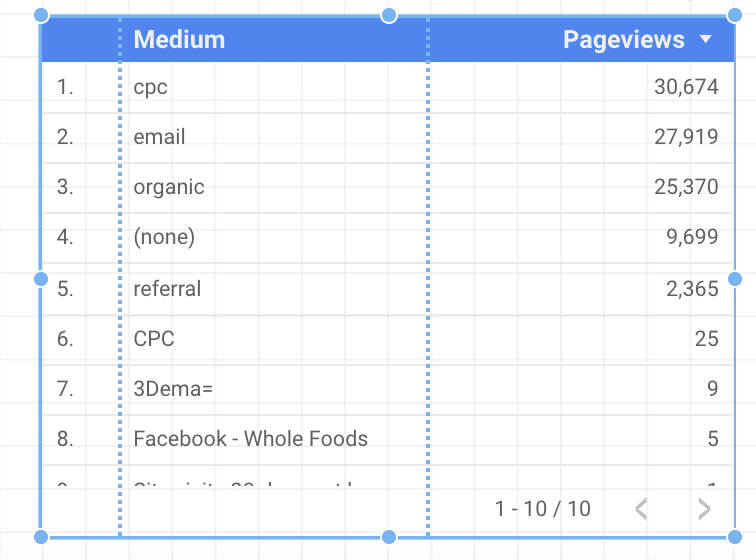
Drag and drop the element into the position you would like. It can be easily moved and resized after placement.
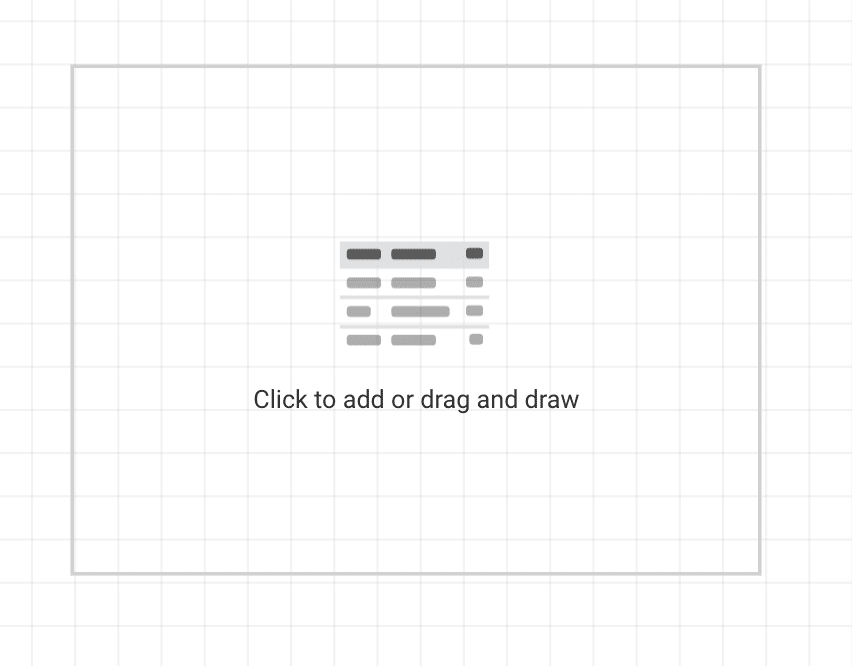
Once your table or element is placed, a right-hand menu will appear:

From this menu you can define dimensions and metrics for the table, which will auto-refresh when new dimensions and metrics are added, changed or removed.
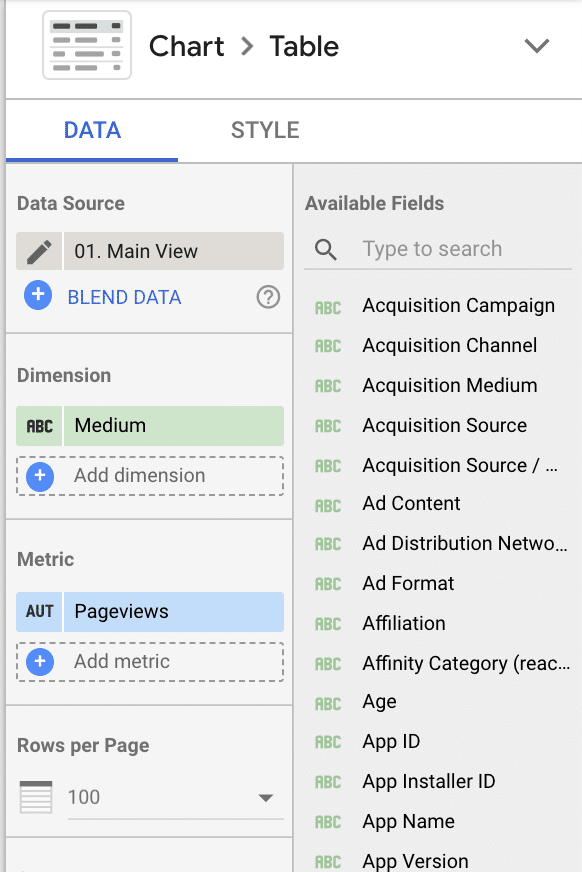
In addition to tables, there are options to add ‘scorecards’, which are useful to highlight hero metrics or KPIs.
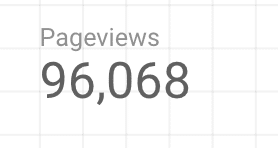
And ‘time series’, which needs a ‘date’ dimension for the x-axis. Time series are useful for understanding how things are trending.
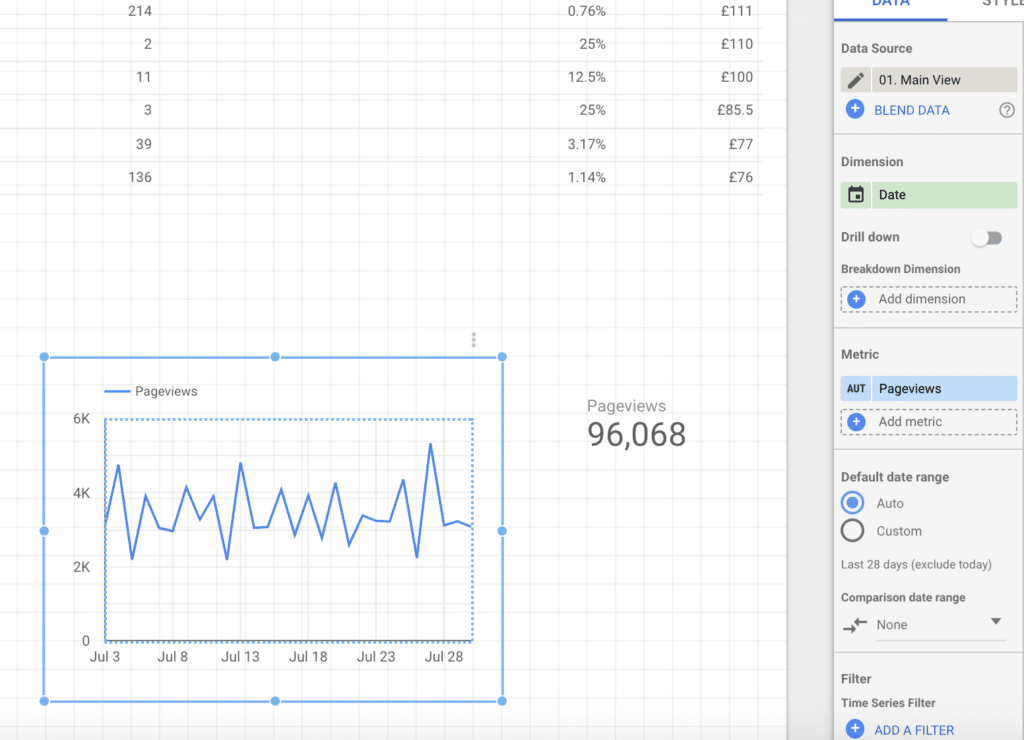
Other options include ‘bar charts’, which offer the most simple visualisation and are useful for comparisons.
‘Pie charts’ are excellent for showing proportionality and share. If you can have percentage breakdowns, then pie charts normally provide a useful visual.
‘Combo’ charts combine bar charts and line charts.
‘Area’ charts are really useful to understand to proportions at specific timeframes (e.g. in July, X channel provided 60% traffic, in August that was 80%). Particular useful context and insight for understanding changes in performance.
‘Scatter’ charts are useful for seeing patterns and outliers, relative to other data points.
‘Pivot tables’ work similarly to Excel pivot tables and give excellent flexibility to drill down into precise perspectives.
‘Bullet charts’ are useful to understand and measure performance versus targets or benchmarks. Currently, the target line is manually updated, eventually it would be realistic to expect this to become automated (e.g. last year’s daily traffic level is the benchmark to surpass).
‘Treemaps’ are a new feature and enable visualise weighting and proportionality, similar to pie charts, though more abstract.

Selecting a date range icon adds a date range select dropdown to the report:

Clicking on ‘Auto date range’ allows editors to set a default date range across the whole report. By default this is set to the past 28 days. Note, the data range specified on each individual table or chart element will take precedence over the default. Selecting a date range will work across different date dimensions e.g selecting 1st January to 31st January would only show ‘January’ if the date dimension is ‘Month’, or week 1-4 is the date dimension is “Week of the year’.
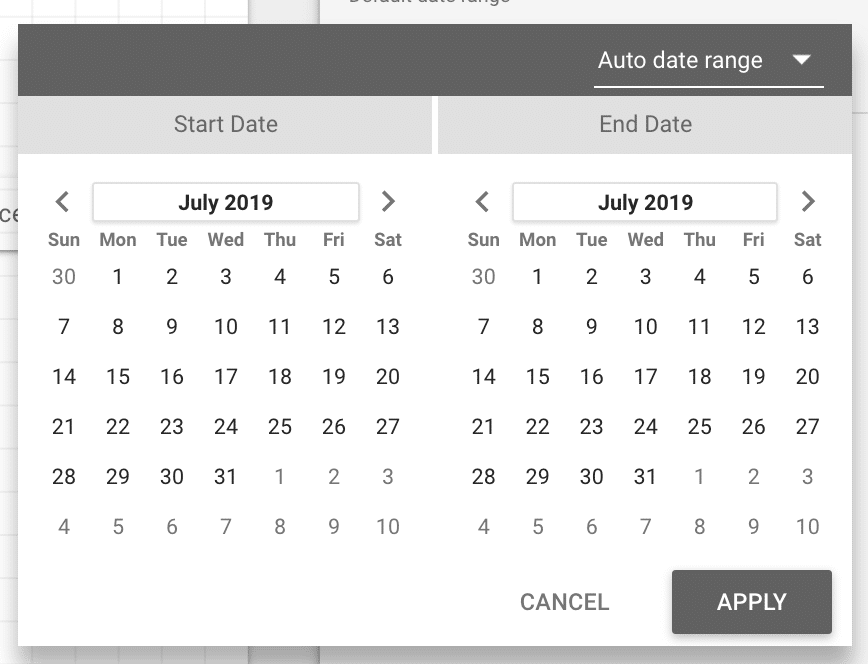

Clicking the filter icon allows end users to self-service and filter data based on their specific needs. For example, the following filters have been created in this example:

If the end user is only interested in knowing how ‘Organic Search’ is performing, then they are able to select the ‘Medium’ filter and choose ‘organic’.
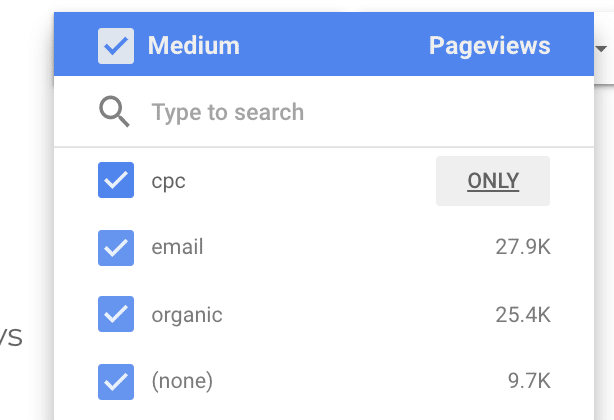
It’s possible to select ‘only’, multiple using the tickboxes, ‘all’ or ‘none’ using the tickbox in the top left (next to ‘Medium’ in this example). It’s also possible to deselect all, type in something (E.g. ‘search’), then tick select ‘all’ and it will select only channels including ‘search’ in the value.
The filter dimension (‘Medium’ in the example) and the metric on the right-side (‘Pageviews’ in the example) is fully customisable and orderable in the right-hand menu.

A nice feature of Data Studio is to be able to quickly, visually compare one data set versus another. Most of the time this relates to comparing performance over time (E.g. how many visitors in the last 7 days compared to the 7 days previous to that? Or how are conversions performing month on month?)
Data Studio has built-in functionality to accommodate this view, with preset options provided such as ‘previous period’ (e.g. the time period selected in the date range); fixed (e.g specific dates that events happened); Year on Year; Advanced (trailing days/dates).
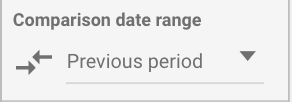
This displays like so:
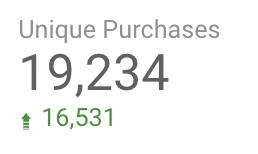
Green, by default being positive, Red, by default being negative. These colours and styling can be easily changed by selecting ‘Style’ in the right-hand menu after selecting an element.
In the right-hand side menu, there are several options such as ‘Rows per page’, which controls how many records show in a table. A summary row appears at the bottom of tables, to show total sums for columns (e.g. total revenue from all channels), or averages (e.g. average click-through rate from all channels)
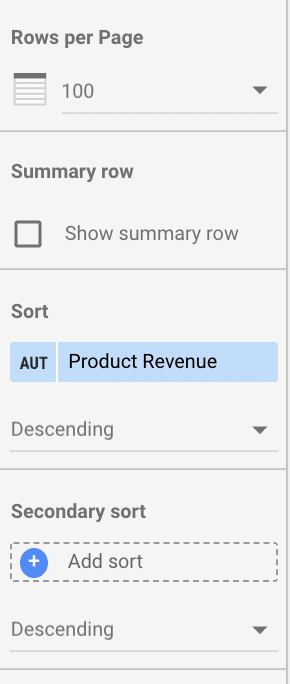
Depending on the perspective/narrative you’re trying to share, the ‘Sort’ column is useful. For instance, sort top selling products by ‘Product Revenue’, or sort Products by number of Transactions. End users have the ability to sort and interact with tables and charts, so this is very much about the first impression.
Filters allow you to remove data that you don’t want appearing in elements. For instance, you may want to remove any NULL instances or, for example, pages than have received less than 5 pageviews.
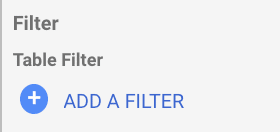
If there are segments available in Google Analytics, these can be pulled in Data Studio (e.g. people who have made purchases). This is particularly useful if clients have advanced segments that they use frequently or refer to. This can be found in the right-hand menus under filters.
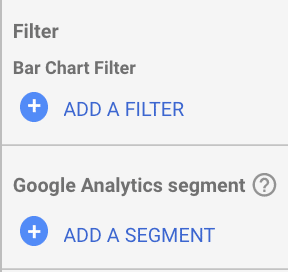
A dollop of new perspective, defined, business-level.
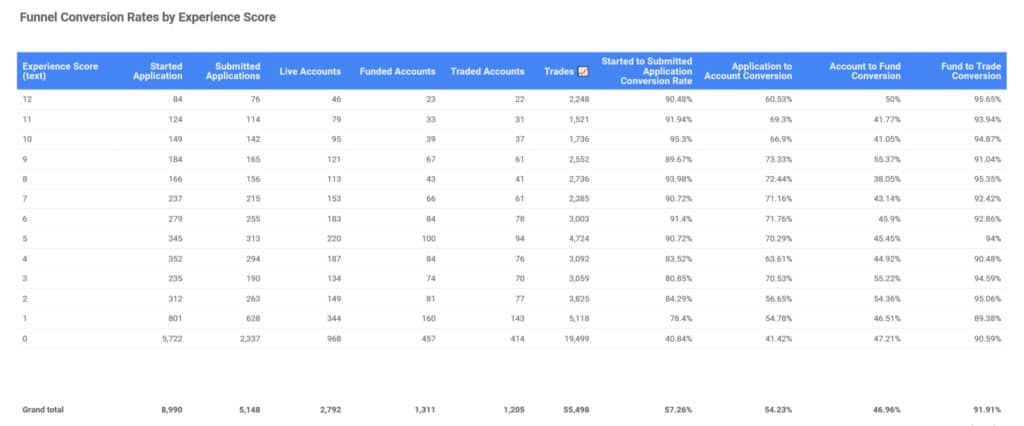
Metricising the product journey to understand; to tune (product, marketing, experience); to shape strategy; to create new metrics and perspectives.
Lots of fun:


















© 2025 Tom Birmingham – Personal Blog
Theme by Anders Noren — Up ↑